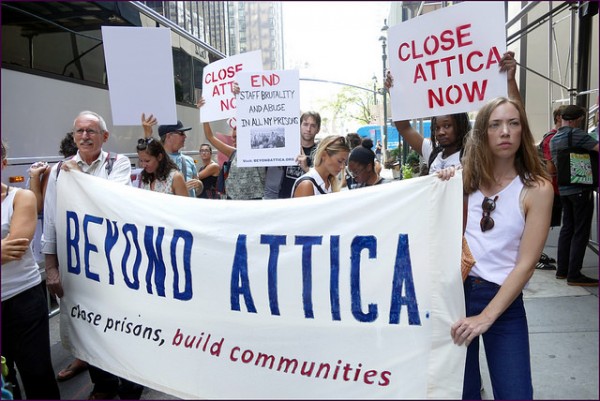
On the recent 45th anniversary of the Attica prison uprising, prisoners in at least 24 states protested inhumane living and working conditions, in what some observers are calling the largest national prison strike in American history. Led by inmate movements in Alabama and Texas that critique prison slavery, protests are still ensuing in many states, with demonstrations ranging from work stoppage to hunger strikes. As historian Heather Ann Thompson reveals in a recent article in the Atlantic, the parallels between these modern prison protests and the Attica prison uprising are clear:
“The root causes of the Attica rebellion were, as they are with the rebellions today, abysmal conditions in our nation’s correctional facilities.”
Thompson argues in her book that the political consequences of the misinformation surrounding Attica helped to legitimate the punitive turn in American imprisonment. Although Attica may have helped to perpetuate some of the problems in American prisons, Thompson believes that it also provides an example to those who are incarcerated that they have ways to take action.
- Heather Ann Thompson. 2016. Blood in the Water: The Attica Prison Uprising of 1971 and Its Legacy. New York City, NY: Pantheon.
The current uprising highlights not only unpaid labor but also issues of dismal healthcare and high rates of suicide in prisons, as well as the overuse of solitary confinement. Prison suicide rates are extremely high compared to the general population, and imprisonment may contribute to racial disparities in midlife physical health functioning. Moreover, solitary confinement significantly damages the mental health of prisoners, especially if used for extended periods of time.
- Lindsay M. Hayes. 1995. “Prison Suicide: An Overview and a Guide to Prevention.“ The Prison Journal 75(4), 431-456.
- Alison Liebling. 1999. “Prison Suicide and Prisoner Coping.” Crime and Justice 26: 283–359.
- Michael Massoglia. 2008. “Incarceration, Health, and Racial Disparities in Health.” Law & Society Review 42(2): 275–306.
Not only are these protests in response to conditions within prisons, but also for related causes such as the school-to-prison pipeline. Recent evidence suggests a strong relationship between school sanctioning and future involvement with the criminal justice system. Thus, many of the concerns of this prisoner movement are empirically supported but have yet to capture attention outside of the prison system.
- David M. Ramey. 2016. “The Influence of Early School Punishment and Therapy/Medication on Social Control Experiences During Young Adulthood.“ Criminology 54(1): 113-141.
- Peter S. Smith. 2006. “The Effects of Solitary Confinement on Prison Inmates: A Brief History and Review of the Literature.“ Crime and Justice 34(1): 441-528.
Want to know more? See here for live updates on the national prison strike.

Comments